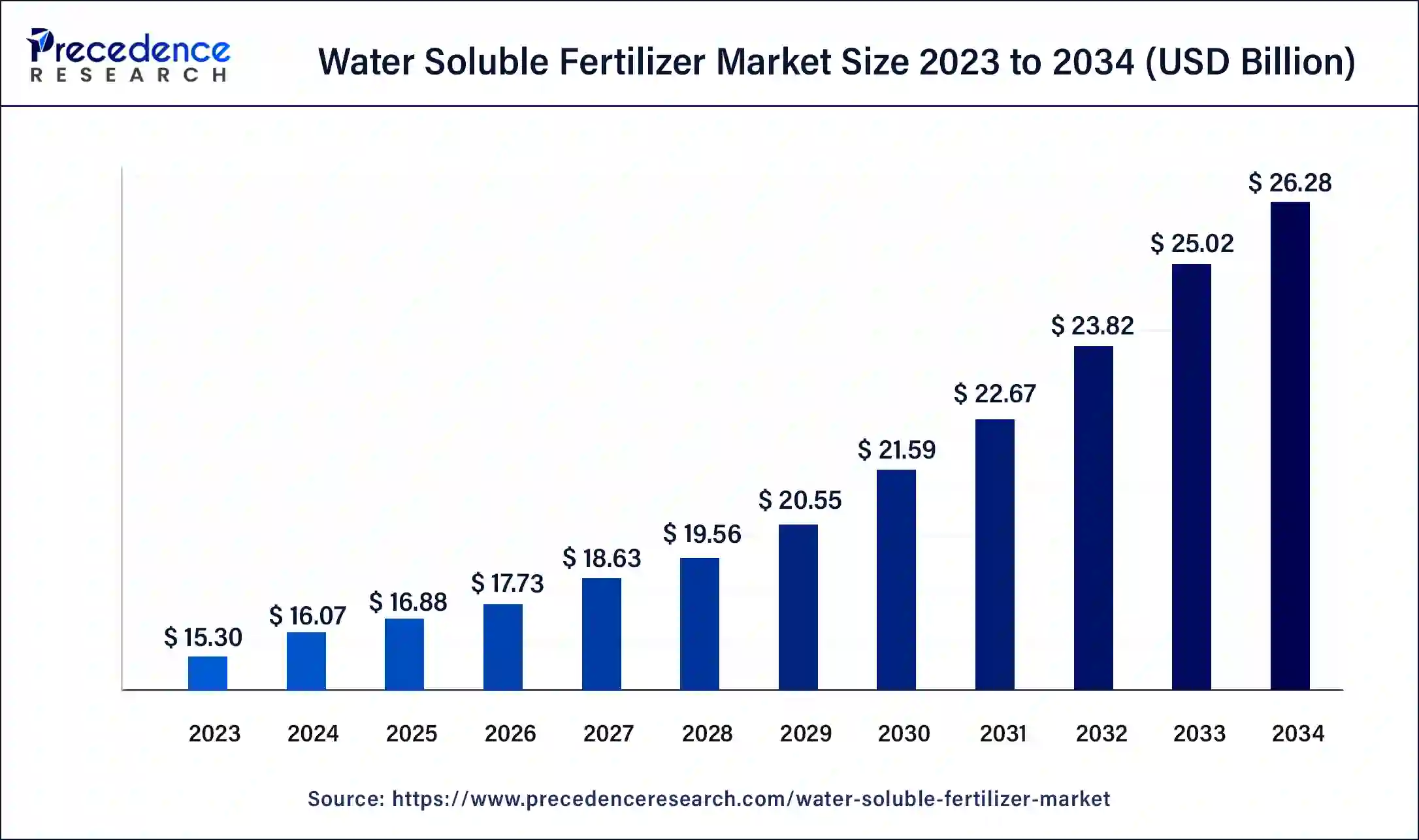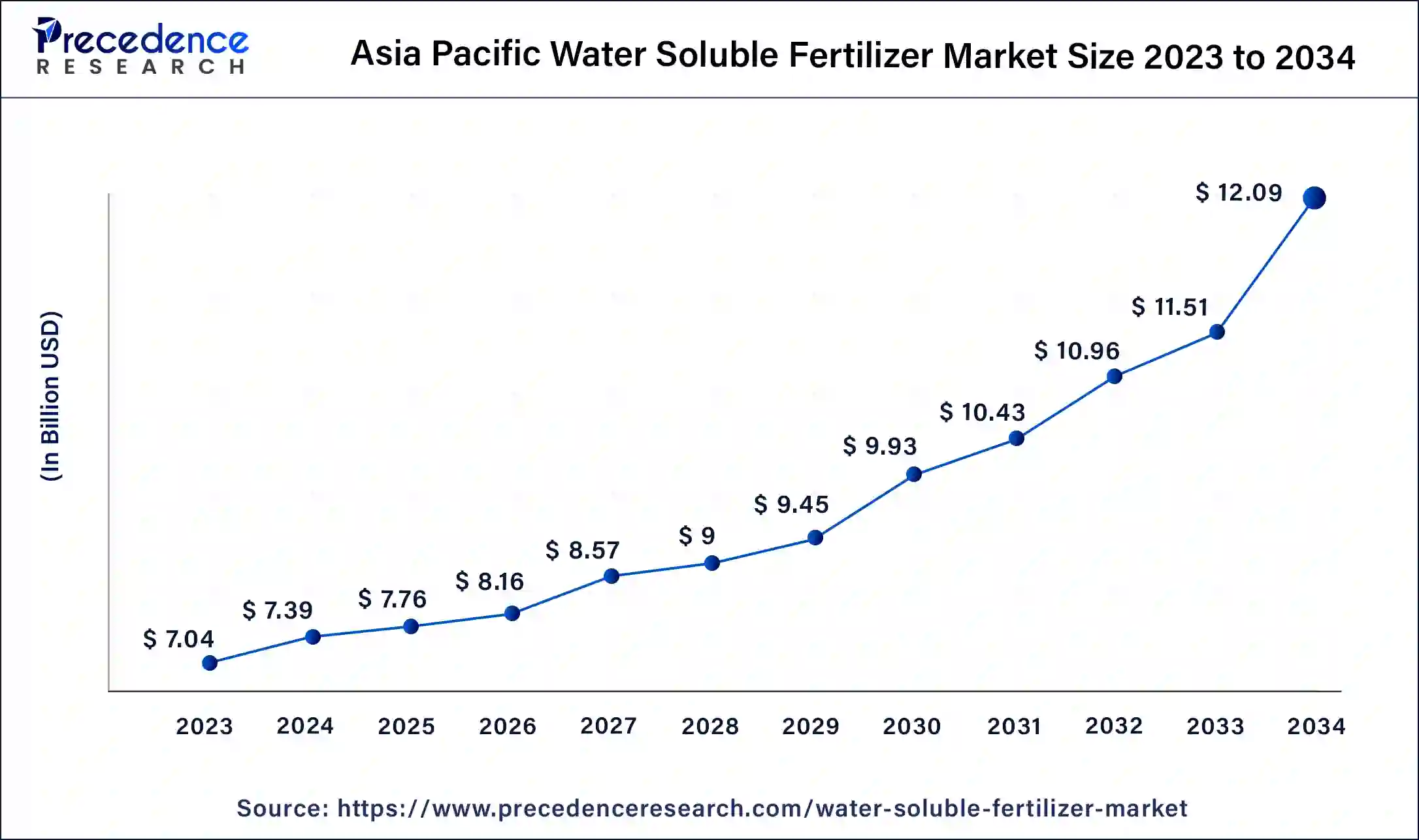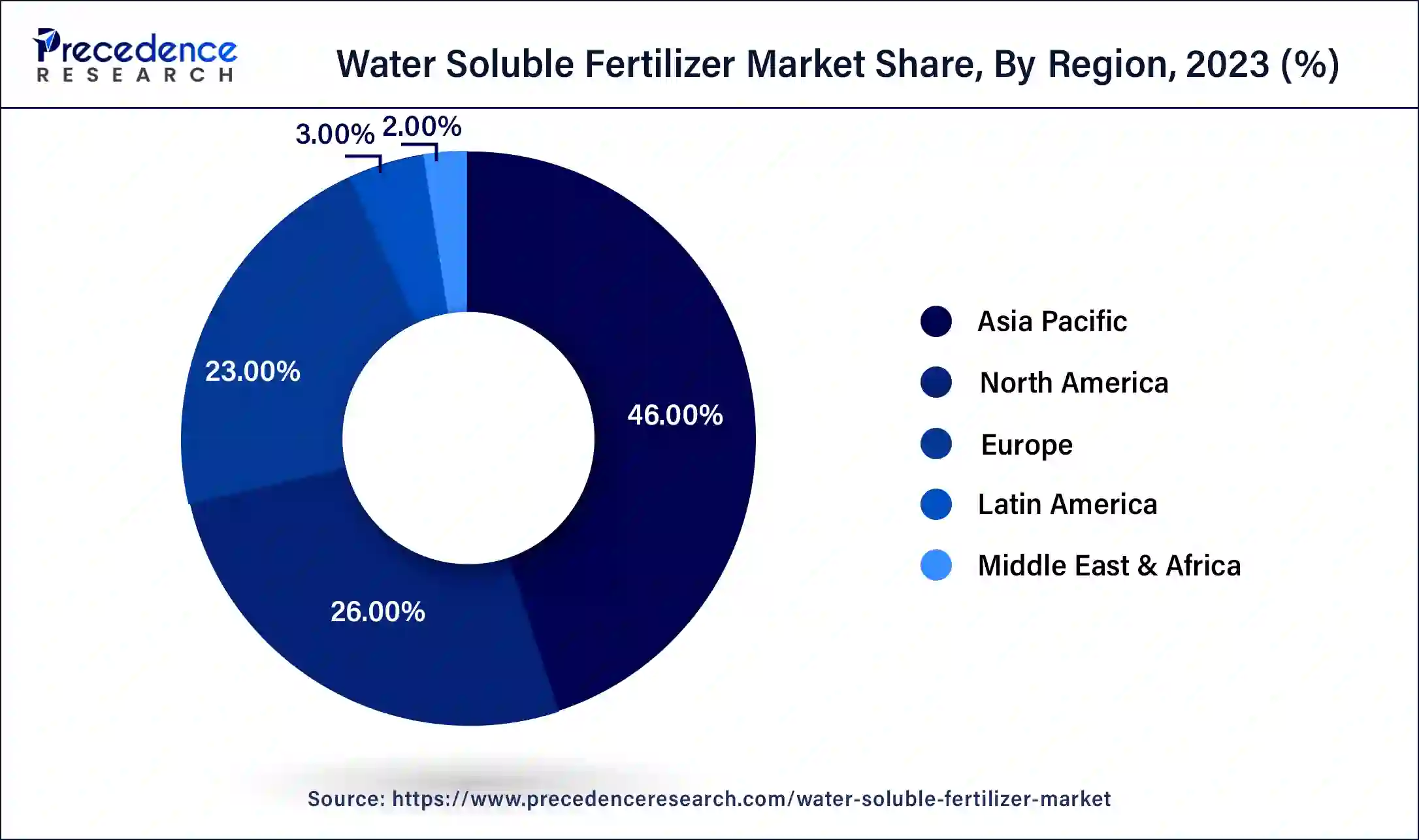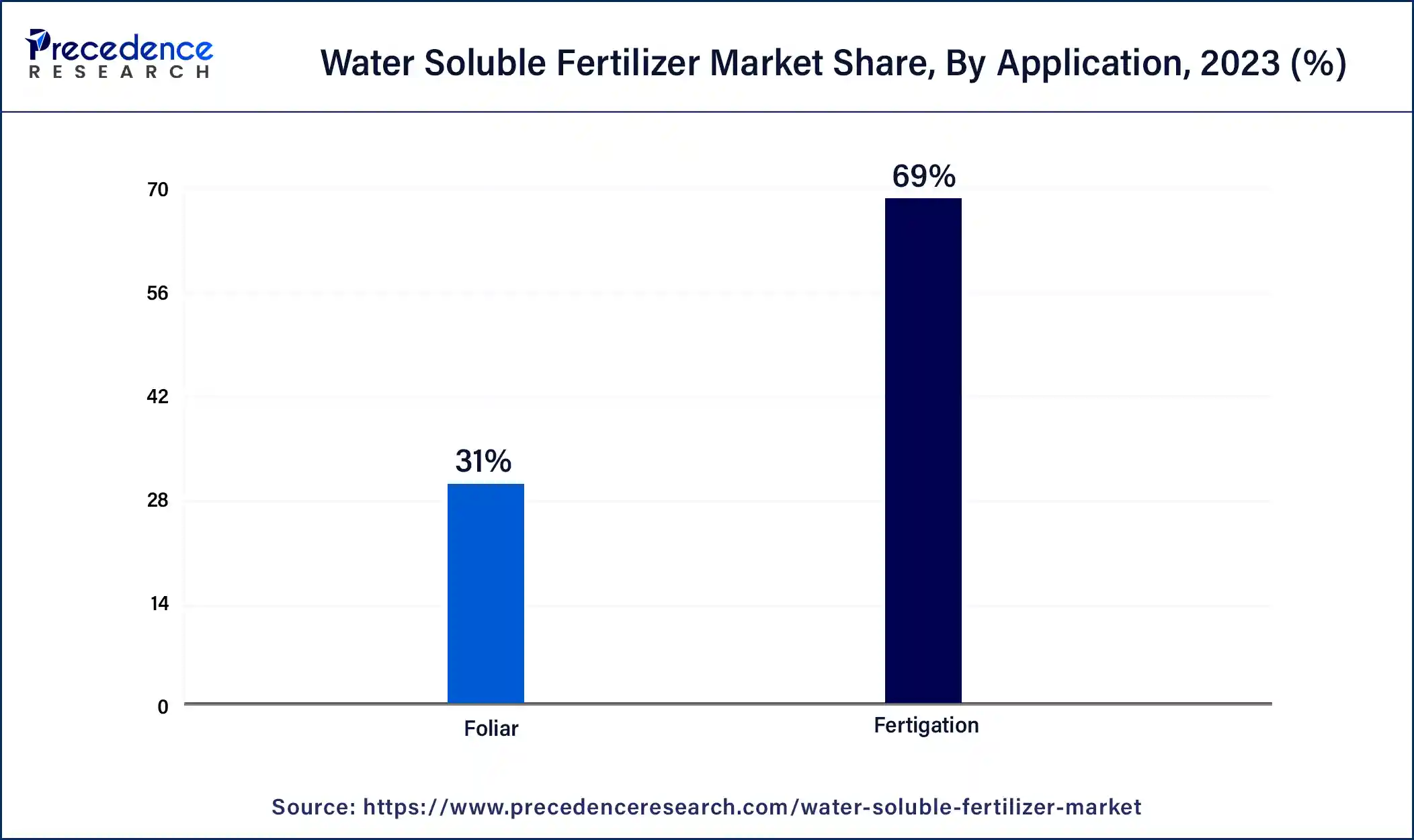February 2025
The global water soluble fertilizer market size was USD 15.30 billion in 2023, calculated at USD 16.07 billion in 2024 and is projected to surpass around USD 26.28 billion by 2034, expanding at a CAGR of 5% from 2024 to 2034.
The global water soluble fertilizer market size accounted for USD 16.07 billion in 2024 and is expected to be worth around USD 26.28 billion by 2034, at a CAGR of 5% from 2024 to 2034. Growers are widely accepting water-soluble fertilizers due to their ease of application, increasing environmental change concerns, and high effectiveness of water-soluble fertilizers. These major factors are driving the water soluble fertilizer market on a global scale.

The Asia Pacific water soluble fertilizer market size was estimated at USD 7.04 billion in 2023 and is predicted to be worth around USD 12.09 billion by 2034, at a CAGR of 5.2% from 2024 to 2034.

Asia Pacific held the dominating share of the market in 2023. Limited resources for farming purposes, including water resources, have escalated the demand for water-soluble fertilizers. Production of high-value crops in Asia and Southeast Asia has been increasing owing to urbanization and the evolving economy, which is expected to fuel market growth. Subsidizing water-soluble fertilizers is anticipated to increase their usage in the farming sector at a higher pace.
For instance, the government of India is promoting fertilizer companies by providing various facilities and funding to increase their production of specialized fertilizers in terms of gaining higher profit margins in the agriculture field for the overall country, as farming is a principal occupation of people in the India and primary income source for the majority of villagers in the country.
Moreover, in the Asia Pacific region, multinational companies like Nutrien and ICL have invested in larger shares, as this region has proliferating opportunities, which makes it an emerging profitable market for the specialized fertilizer market.
Europe is observed to witness significant growth due to the high adoption of specialized fertilizers in countries such as France, Russia, and Spain. This growth is further bolstered by the expansion of many businesses in the fertilizer production sector over the past few years. A prime example of this expansion is the inauguration of a water-soluble fertilizer production plant in Lithuania in 2018 by EuroChem Group, a leading global business group in fertilizer production. With an investment of up to USD 16 million, this move has further solidified Europe's global water soluble fertilizer market growth.

The global water soluble fertilizer market has seen rapid growth over a short period of time, and it is anticipated to grow further due to the higher crop production in the global market. Water soluble fertilizers are easily blended into the water, making them convenient for use, and they can be removed from the soil very quickly. Using water-soluble fertilizer makes it easy to control the precise number of nutritional values that crops need to get the best out of it. These water-soluble fertilizers consist of NPK numbers, which mention the grades of nutrients available in them and not about concentration. Here, N is nitrogen, P is for phosphorus, and K is for potassium. Nitrogen is the most vital component as it contributes to making protoplasm in the cells, which makes proteins in the plant.
Nitrogen is required for the growth of the plants as it supports new plant leaf growth by using the production of chlorophyll. Meanwhile, phosphorus is essential for photosynthesis, which supports plants' energy transfer mechanism. Potassium provides movement of starches and sugars required for growth. Additionally, fertilizer also has micronutrients in it for the complete development of plants. Due to such benefits, farmers or growers increasingly use this fertilizer as their routine owing to the awareness about precise farming that requires acute care and a specific number of fertilizers. Cereals need more water-soluble fertilizer than any other crops. Using water-soluble fertilizer in cereal crops can help greatly achieve the health and quality of cereal crops. As water-soluble fertilizers can easily provide life-essential nutrients for the optimal growth of plants, they are now widely used by several growers.
| Report Coverage | Details |
| Growth Rate from 2024 to 2034 | CAGR of 5% |
| Global Market Size in 2023 | USD 15.30 Billion |
| Global Market Size in 2024 | USD 16.07 Billion |
| Global Market Size by 2034 | USD 26.28 Billion |
| Largest Market | Asia Pacific |
| Base Year | 2023 |
| Forecast Period | 2024 to 2034 |
| Segments Covered | By Form, By Type, By Application, and By Crop Type |
| Regions Covered | North America, Europe, Asia-Pacific, Latin America, and Middle East & Africa |
Increasing demand for high value crops
The demand for water-soluble fertilizer is expected to witness a rapid surge in the market during the foreseen years owing to the higher requirement of specialized fertilizers for different types of crops, which in turn enhances the farming production of high-value crops as people become more aware of the fertilizers and its side effects on plants they tend to be more cautious while food consumption and production solution. Moreover, the rising world population in developing countries has already raised concerns about the quality of food production and its security.to overcome such a problem, government authorities of many countries, including the agriculture sector, have initiated several programs to spread awareness about specialized fertilizers for better plant quality and make farmers educated about the type of fertilizers and their quantity use, which aids the water soluble fertilizer market growth.
Overpricing of water-soluble fertilizer
The high price of fertilizers for high-value crops, such as water-soluble fertilizers, can act as a major barrier to market growth. As specialized fertilizers are overpriced due to the production cost, it is not reasonable for farmers in developing and underdeveloped countries where such a high-value fertilizer is needed most in terms of increasing the growth index for the farming sector. To overcome this budget issue, stakeholders of the fertilizer industry are investing in research and development activities to produce more efficient and cost-friendly products of high-value fertilizer, and they also focus on the technologies that could be merged into fertilizer production to evaluate and increase the efficacy of the fertilizer production. Such continued efforts may reduce the overpricing of high-value fertilizers and make them available even for low-margin farmers and in countries with low per capita income.
Rising importance of water-soluble fertilizer
The growing population requires more food grains, vegetables, fruits, etc., increasing demand to adopt farming more significantly globally—such an increasing demand in the farming sector fuels water soluble fertilizer market growth. Healthy crops need specialized fertilizers with micro-irrigation. Water-soluble fertilizers can be easily sprinkled using a water irrigation system, which enhances the productivity of crops overall. Additionally, many government bodies support the farming sector with several initiatives and funding, which help fuel market growth further and create tremendous career opportunities in this field.
The dry powder segment of fertilizer dominated the market and is expected to acquire higher growth among the water-soluble fertilizer types. These are available in a granular form or a fine powder form so that they blend easily with the base compound, which is usually water. As fertilizer in granular or powder form dissolves quickly in the water, it is applied to the plants and absorbed by the crops effectively.
Also, they are easy to store and transport and do not have any deformation from climatic changes. Dry water-soluble fertilizer can be applied directly by using a micro irrigation system. These fertilizers comprise various essential nutrients that help crops grow at their highest possibility and quality.
The demand for nitrogenous fertilizer segment remains dominant throughout the years which also held the largest share in 2023. It is anticipated to witness robust growth on a global scale over the forecast period owing to its higher production rate. Rising concerns such as loss of crops due to the uncertain weather conditions because of global warming effect may decrease plant production. To conquer such matters related to farming methods, the demand for phosphatic fertilizers is anticipated to see higher growth in the forecast period.
The fertigation segment held the largest share of the water soluble fertilizer market. Fertigation is a fertilizer application to the crops. Using this method, nutritional deficiency in crops can be controlled significantly. The application method is mostly preferable due to its effectiveness, and it saves up to 25% of fertilizer usage.

The fertigation method is the proper method to apply fertilizer and produces the utmost production through it as water-soluble fertilizers are costly; it is essential not to waste it and use it properly with the predefined method. Due to these conditions, fertigation is the most preferable application method used on a global level.
The horticulture segment is dominating the global market, and it is anticipated to witness massive growth over the forecast period. it is the fastest-growing segment due to the increasing demand for nutritional-rich and organic food diets worldwide. To achieve this, high-value crops need to be planted and flourish more widely. Many horticulture crops require various nutrients and favourable weather conditions for proper growth. These specialized fertilizers can provide nutritional value for the crops.
Segments Covered in the Report
By Form
By Type
By Application
By Crop Type
By Geography
For inquiries regarding discounts, bulk purchases, or customization requests, please contact us at sales@precedenceresearch.com
No cookie-cutter, only authentic analysis – take the 1st step to become a Precedence Research client
February 2025
September 2024
October 2024
September 2024